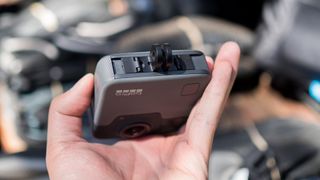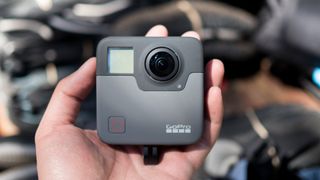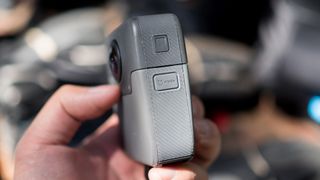GoPro Fusion first look: going beyond VR
Changing how video is captured and edited

Virtual reality arrived with a lot of hype, but challenges have prevented it from being adopted by mainstream consumers. While the HTC Vive and Oculus Rift are excellent VR experience, not everyone has thousands of dollars or the space to invest in a VR setup.
Mobile VR like the Samsung Gear VR and Google Daydream View are arguably more exciting, allowing you to take VR experiences wirelessly and on the go. However, VR still requires powerful hardware and a head-mounted display that you probably won’t carry with you all the time.
Likewise, there are plenty of 360-degree action cams out there, but it’s still difficult to edit and share the video captured on these devices. GoPro Fusion hopes to fix that by not only offering a stellar hardware experience, but also allowing users to over capture video data to alter the perspective of 360-degree videos in real time.
Price and release date
Little is known about the GoPro Fusion, which was announced via a blog post back in April 2017. GoPro has not released any pricing information but it aims to release the camera by the end of 2017.

Design and specs
GoPro is playing things close to the chest with the Fusion and little is known about the hardware specifications of the camera. What we know is that the camera is capable of 5.2k resolution capture at 30 frames per second (fps). GoPro declined to comment if higher fps capture would be available.
Externally, the GoPro Fusion looks like a square bar of soap that is considerably bigger than the GoPro Hero5 line of cameras. The extra size allowed GoPro to pack two cameras on the device; one on the front and one on the back.

Fusion also retains the company’s grey-on-grey styling with the small LCD screen found on its Hero cameras. The camera also has an integrated – and removable – mount on the bottom, which mostly eliminates the need of housings unlike all of GoPro’s past cameras.
Get daily insight, inspiration and deals in your inbox
Get the hottest deals available in your inbox plus news, reviews, opinion, analysis and more from the TechRadar team.

One interesting thing to note is that there appears to be three microphone holes on top of the camera as well as an additional cavity on the rear. While GoPro declined to comment, we speculate that these mics will provide directional audio for 360-degree videos.
GoPro also declined to comment on whether the Fusion would be waterproof, though its similarities in design with the waterproof GoPro Hero 5 hints that the camera is indeed waterproof.

Changing perspectives in real time
VR hype arguably came and went, leaving consumers underwhelmed by the inconveniences of jumping to the new format. VR requires a ton of processing power to render, requires specific hardware and is difficult to share with a group of friends.
Instead of jumping on the 360-degree VR video bandwagon, GoPro is taking a different approach with what it calls OverCapture. It’s a fancy term for capturing more video data than is necessary for either gorgeous 360 movies or allow you to compose traditionally flat videos that convey their story through changes in perspective .

With OverCapture, the GoPro Fusion allows you to dynamically change the perspective of the video as the camera captures footage from all angles. This allows you to do slick edits with seamless transitions from the front camera, back camera or to a full “tiny world” perspective where everything is visible. The feature will also let you punch into a 1080p resolution frame from any angle.
One area where 360-degree cameras typically struggle with is making seamless stitches. You’ll notice a blurry effect as you look around since complex software is required to stitch the two video feeds together in real time.
With our short hands-on experience with the GoPro Fusion, we came away impressed by how the stitches nearly invisible, though there is still some distortion and blur on the top and bottom of the video.
If you have a VR headset, you can watch for yourself below.
For example of what’s capable with OverCapture, check out GoPro’s flat cut of the above video below.
With OverCapture, you can change perspectives and reframe a shot in anyway you want to best present what you want people to see. It’s like you’re using a camera crane that can smoothly pivot 360-degrees. But instead of having a setup that costs thousands of dollars, you just need a GoPro Fusion and the company’s editing software.

Only as good as its software
GoPro is late to the 360-degree action cam game with competitors like the Samsung Gear 360, LG 360 Cam and Kodak PIXPRO Orbit360 4K having come out last year. However, GoPro will differentiate the GoPro Fusion by packing in stellar software.
We got our hands on a new, beta version of the GoPro Quik video editing app and came away impressed at how easily you could cut together video to share quickly on social networks. The beta version of Quik continuously syncs video taken from your GoPro to your smartphone, creating a shareable “story” for you while you go about your day.
The constant Wi-Fi connection will drain the camera’s battery more quickly, so you’ll want to double up on batteries if you plan on using this feature. GoPro is targeting an end-of-summer release date for the updated Quik app and the constant sync feature will first come to GoPro Hero5 cameras.

Quik includes an editing presets that automatically tune your captured videos and photos to music and syncs transitions to the beat of the song. Users can also choose the duration of the overall video to make it easy to share to social networks like Instagram, which has a 60 second time limit. Other options and tools dive deeper into edits for the perfect video.
One of the biggest problems with any video camera is the amount of time and effort it takes to edit and share videos. With GoPro Quik, most or all of the work is taken out of video editing. But don’t think GoPro is leaving behind its pro users. The Quik app has tons of features that more advanced users can dig into to create the perfect video right on your phone.
After our short time spent with the GoPro Fusion and GoPro’s software suite, it’s clear that GoPro believes 360-degree capture is the future of video recording. VR may not have caught on, but giving users the flexibility to create VR videos while also creating dramatic flat videos is something GoPro thinks users will get excited about and actually use.
Most Popular



